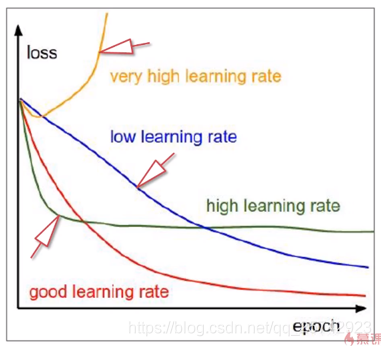目录
环境
python 3.6 + TensorFlow 1.13.1 + Jupyter Notebook
介绍
机器学习步骤
- 数据预处理(采集+去噪);
- 模型训练(特征提取+建模);
- 模型评估与优化(loss、accuracy及调参);
- 模型应用。
深度学习、机器学习、人工智能三者的关系
引自:https://coding.imooc.com/class/259.html

神经网络
神经元是最小的神经网络,以3个神经元为例,结构为:

其表达式为:
其中,为权重,x为特征,f()为激活函数,b为偏置。
计算举例:
若:
则:
二分类逻辑斯地回归模型
引自:https://coding.imooc.com/class/259.html

多分类逻辑斯地回归模型

目标函数(损失函数)
目标函数用于衡量对数据的拟合程度。
主要类型
1、二分类:真实值-预测值;
2、多分类:abs(真实值做one-hot编码-预测的概率分布);
3、平方差损失,表达式为:
4、交叉熵损失(更适合做多分类的损失函数),表达式为:
注意:多分类在计算目标函数时可以通过one-hot编码实现。
One-hot编码:数值到向量的变换,只有一个位置为1,其他位置均为0。
举例
1、二分类:

2、多分类:

神经网络训练
训练目标
调整参数使得模型在训练集上的损失函数最小。
梯度下降算法
下山算法:找到方向;走一步。引自:https://coding.imooc.com/class/259.html

梯度下降算法与下山算法思想类似:
学习率(步长):,人为设置的,不能过大、过小;
方向:。
学习率的影响如下图所示:

引自:https://coding.imooc.com/class/259.html
TensorFlow实现
计算图模型
命令式编程

声明式编程
先构建图,再填入数据计算。

二者的对比
引自:https://coding.imooc.com/class/259.html

数据处理
下载数据
以CIFAR10为例,下载链接:http://www.cs.toronto.edu/~kriz/cifar.html
准备工作
需要安装包:
在python 2.x中,安装cPickle;
pip install cPickle在python 3.x中,安装Pickle(建议);
pip install Pickle注意:python 3.x也可以用_pickle代替Pickle包(不建议,亲测后面程序报错,不知道是不是这个包的数据导入问题):
import _pickle as cPickle读取数据
import os
import numpy as np
import tensorflow as tf
# import _pickle as cPickle
import pickle
cifar_dir = 'dataset/cifar-10-batches-py/'
print(os.listdir(cifar_dir))运行结果:

查看数据
查看数据结构:
with open(os.path.join(cifar_dir, 'data_batch_1'), 'rb') as f:
data = cPickle.load(f, encoding='bytes')
print(type(data))
print(type(data[b'batch_label']))
print(type(data[b'labels']))
print(type(data[b'data']))
print(type(data[b'filenames']))
print(data[b'data'].shape) # 32 * 32 = 1024 * 3 = 3072
print(data[b'data'][0:2])
print(data[b'labels'][0:2])
print(data[b'batch_label'])
print(data[b'filenames'][0:2])运行结果:

查看某一张图:
img_arr = data[b'data'][100]
img_arr = img_arr.reshape((3,32,32))
img_arr = img_arr.transpose((1,2,0))
import matplotlib.pyplot as plt
from matplotlib.pyplot import imshow
%matplotlib inline
imshow(img_arr)运行结果:

注意:这里需要转换通道,不然图片无法正常显示。
原数据集的每张图的格式为:[32, 32, 3] -> 32 * 32 * 3 = 1024 * 3 = 3072
而我们显示出来的图需要的格式为:[3, 32, 32] -> 3 * 32 * 32 = 3 * 1024 = 3072
数据读取及预处理整体代码
import os
import numpy as np
import tensorflow as tf
# import _pickle as cPickle
import pickle
cifar_dir = 'dataset/cifar-10-batches-py/'
# cifar_dir = 'I:/jupyterWorkDir/testTensorFlow/code/coding-others/cifar-10-batches-py/'
print(os.listdir(cifar_dir))
CIFAR_DIR = cifar_dir
def load_data(filename):
"""read data from data file."""
with open(filename, 'rb') as f:
data = pickle.load(f, encoding='bytes')
return data[b'data'], data[b'labels']
# tensorflow.Dataset.
class CifarData:
def __init__(self, filenames, need_shuffle):
all_data = []
all_labels = []
for filename in filenames:
data, labels = load_data(filename)
all_data.append(data)
all_labels.append(labels)
self._data = np.vstack(all_data)
self._data = self._data / 127.5 - 1
self._labels = np.hstack(all_labels)
print(self._data.shape)
print(self._labels.shape)
self._num_examples = self._data.shape[0]
self._need_shuffle = need_shuffle
self._indicator = 0
if self._need_shuffle:
self._shuffle_data()
def _shuffle_data(self):
# [0,1,2,3,4,5] -> [5,3,2,4,0,1]
p = np.random.permutation(self._num_examples)
self._data = self._data[p]
self._labels = self._labels[p]
def next_batch(self, batch_size):
"""return batch_size examples as a batch."""
end_indicator = self._indicator + batch_size
if end_indicator > self._num_examples:
if self._need_shuffle:
self._shuffle_data()
self._indicator = 0
end_indicator = batch_size
else:
raise Exception("have no more examples")
if end_indicator > self._num_examples:
raise Exception("batch size is larger than all examples")
batch_data = self._data[self._indicator: end_indicator]
batch_labels = self._labels[self._indicator: end_indicator]
self._indicator = end_indicator
return batch_data, batch_labels
train_filenames = [os.path.join(CIFAR_DIR, 'data_batch_%d' % i) for i in range(1, 6)]
test_filenames = [os.path.join(CIFAR_DIR, 'test_batch')]
train_data = CifarData(train_filenames, True)
test_data = CifarData(test_filenames, False)构建模型
构建计算图
构建x和y,x为输入的数据,y为标签(label),placeholder理解为占位符。
# (None, 3072)
x = tf.placeholder(tf.float32, [None, 3072])
# (None)
y = tf.placeholder(tf.int64, [None])构建隐含层:
hidden1 = tf.layers.dense(x, 100, activation=tf.nn.relu)
hidden2 = tf.layers.dense(hidden1, 100, activation=tf.nn.relu)
hidden3 = tf.layers.dense(hidden2, 50, activation=tf.nn.relu)构建w,b和_y,其中w为权重,b为偏置(bias),_y为预测值。
# (3072, 1)
w = tf.get_variable('w', [x.get_shape()[-1], 1],
initializer = tf.random_normal_initializer(0,1))
# (1)
b = tf.get_variable('b', [1],
initializer = tf.constant_initializer(0.0))
# (None, 3072) * (3072, 1) = (None. 1)
y_ = tf.matmul(x,w) + b这一步等价于:
y_ = tf.layers.dense(hidden3, 10)构建预测值的概率分布(p_y_1)和loss(平方差损失)。
# 得到y=1的概率
# (None, 1)
p_y_1 = tf.nn.sigmoid(y_)
# 计算loss (平方差损失)
# (None, 1)
y_reshape = tf.reshape(y, (-1, 1))
y_reshape_float = tf.cast(y_reshape, float32)
loss = tf.reduce_mean(tf.square(y_reshape_float, p_y_1))这一步等价于:
loss = tf.losses.sparse_softmax_cross_entropy(labels=y, logits=y_)
构建accuracy:
# 计算accuracy
# bool
predict = p_y_1 > 0.5
# bool [0,0,1,1,1,0,1,1,1]
correct_prediction = tf.equal(y_reshape_float, tf.cast(predict, float32))
accuracy = tf.reduce_mean(tf.cast(correct_prediction, float64))这一步等价于:
# indices
predict = tf.argmax(y_, 1)
# [1,0,1,1,1,0,0,0]
correct_prediction = tf.equal(predict, y)
accuracy = tf.reduce_mean(tf.cast(correct_prediction, tf.float64))调整learning rate,优化loss:
# (1e-3)是初始化的learning rate
with tf.name_scope('train_op'):
train_op = tf.train.AdamOptimizer(1e-3).minimize(loss)构建模型整体代码
# 构建计算图
# (None, 3072)
x = tf.placeholder(tf.float32, [None, 3072])
# (None)
y = tf.placeholder(tf.int64, [None])
hidden1 = tf.layers.dense(x, 100, activation=tf.nn.relu)
hidden2 = tf.layers.dense(hidden1, 100, activation=tf.nn.relu)
hidden3 = tf.layers.dense(hidden2, 50, activation=tf.nn.relu)
'''# (3072, 1)
w = tf.get_variable('w', [x.get_shape()[-1], 1],
initializer = tf.random_normal_initializer(0,1))
# (1)
b = tf.get_variable('b', [1],
initializer = tf.constant_initializer(0.0))
# (None, 3072) * (3072, 1) = (None. 1)
y_ = tf.matmul(x,w) + b'''
y_ = tf.layers.dense(hidden3, 10)
'''# 得到y=1的概率
# (None, 1)
p_y_1 = tf.nn.sigmoid(y_)
# 计算loss (平方差损失)
# (None, 1)
y_reshape = tf.reshape(y, (-1, 1))
y_reshape_float = tf.cast(y_reshape, float32)
loss = tf.reduce_mean(tf.square(y_reshape_float, p_y_1))'''
loss = tf.losses.sparse_softmax_cross_entropy(labels=y, logits=y_)
'''# 计算accuracy
# bool
predict = p_y_1 > 0.5
# bool [0,0,1,1,1,0,1,1,1]
correct_prediction = tf.equal(y_reshape_float, tf.cast(predict, float32))
accuracy = tf.reduce_mean(tf.cast(correct_prediction, float64))'''
# indices
predict = tf.argmax(y_, 1)
# [1,0,1,1,1,0,0,0]
correct_prediction = tf.equal(predict, y)
accuracy = tf.reduce_mean(tf.cast(correct_prediction, tf.float64))
'''# 梯度下降法优化loss
# (1e-3)是初始化的learning rate
# AdadeltaOptimizer是梯度下降的变种,用于调整learning rate,
# 这是在loss上做,优化最小化的loss值
with tf.name_scope('train_op'):
train_op = tf.train.AdadeltaOptimizer(1e-3).minimize(loss)'''
with tf.name_scope('train_op'):
train_op = tf.train.AdamOptimizer(1e-3).minimize(loss)
初始化及运行模型
整体代码
# 初始化
init = tf.global_variables_initializer()
batch_size = 20
train_steps = 100000
test_steps = 100
# run 100k: 50.5%
with tf.Session() as sess:
sess.run(init)
for i in range(train_steps):
batch_data, batch_labels = train_data.next_batch(batch_size)
loss_val, acc_val, _ = sess.run(
[loss, accuracy, train_op],
feed_dict={
x: batch_data,
y: batch_labels})
if (i+1) % 500 == 0:
print('[Train] Step: %d, loss: %4.5f, acc: %4.5f'
% (i+1, loss_val, acc_val))
if (i+1) % 5000 == 0:
test_data = CifarData(test_filenames, False)
all_test_acc_val = []
for j in range(test_steps):
test_batch_data, test_batch_labels \
= test_data.next_batch(batch_size)
test_acc_val = sess.run(
[accuracy],
feed_dict = {
x: test_batch_data,
y: test_batch_labels
})
all_test_acc_val.append(test_acc_val)
test_acc = np.mean(all_test_acc_val)
print('[Test ] Step: %d, acc: %4.5f'
% (i+1, test_acc))
注意事项
1、有时候报莫名其妙的错,建议先检查python版本和运行环境,我之前就是环境运行错了,改错改到怀疑人生,附上代码:
# 查看python版本及运行环境的路径
import sys
print(sys.version)
print(sys.executable)2、在python 2.x中,读取数据集为:
def load_data(filename):
"""read data from data file."""
with open(filename, 'rb') as f:
data = cPickle.load(f)
return data['data'], data['labels']在python 3.x中,读取数据集为:
def load_data(filename):
"""read data from data file."""
with open(filename, 'rb') as f:
data = pickle.load(f, encoding='bytes')
return data[b'data'], data[b'labels'](1)在python 3.x中,如果没有加encoding则会报错:
'ascii' codec can't decode byte 0x8b in position 6: ordinal not in range(128)
(2)在python 3.x中,data['']如果没有加'b'则会报错:KeyError

参考资料
图片、教程及内容:https://coding.imooc.com/class/259.html
API帮助文档:http://www.tensorfly.cn/tfdoc/api_docs/index.html























 1284
1284











 被折叠的 条评论
为什么被折叠?
被折叠的 条评论
为什么被折叠?








